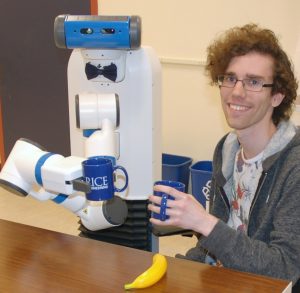 “The NSF research fellowship is like the gold standard,” he said, “and it still feels pretty surreal that I even got it, to be honest.” First year computer science Ph.D. student Zak Kingston is describing the National Science Foundation award he recently received to pursue his study of motion planning in robots.
“The NSF research fellowship is like the gold standard,” he said, “and it still feels pretty surreal that I even got it, to be honest.” First year computer science Ph.D. student Zak Kingston is describing the National Science Foundation award he recently received to pursue his study of motion planning in robots.
Kingston said he considers the funding as a vote of confidence. “the NSF has said ‘we are interested in what you are working on and the work you are going to do,’ and now I’m funded to pursue that work. It’s definitely an investment in my research, and that is important for researchers – to be funded for the research they want to do.”
He arrived at Rice University as an undergraduate with an interest in computational study and he hoped to pursue an advanced degree at some point. “I wasn’t confident in myself as a freshman, so I didn’t begin look for research opportunities until I was a sophomore,” he said. He spent the summer after his sophomore year working in the Multi-Robot Systems Lab of CS professor James McLurkin.
“I knew then that research was definitely what I wanted to do. Working closely with one of his graduate students and publishing research was really engaging.”
In the fall of his junior year, Kingston took Dr. Lydia Kavraki’s robotics course, COMP 450. He said, “She was really impressed by my final project and invited me to work in her lab. I began working on workspace kinematics with Dr. Neil Dantam, a postdoctoral researcher in the lab. The work is heavily based in geometry, linear algebra, and real analysis –we apply continuous reasoning over space– and I found that appealing.”
Three years later, he still finds the combination of theoretical work and mathematics appealing. “I never had any desire to go into industry,” he said, “I always wanted to do research work in a university or lab. So when I looked at Ph.D. programs, I was looking at programs that fit my interests and had faculty I wanted to work with. Rice was my first choice because I loved working with Lydia –she’s a great adviser—and I loved the environment at Rice.
“A lot of Lydia’s work and the work her students do is on motion planning – how to make a robot move. A person might think, ‘I want to set the table,’ and their hands and arms just complete the actions. But a robot has to consider and the plan the series of motions – how to reach, grasp, and manipulate objects in the world. Dealing with the messiness and continuity of the real world requires methods that are unique in computer science; I love the mathematical formulation of the problem and the way motion planning leverages that.”
In 2016, Kingston spent his summer working at NASA’s Johnson Space Center, working on the problem of constrained motion planning for Robonaut 2. He said that where artificial intelligence has been most successful is in virtual environments, but manipulating objects in a physical world is much more complex.
“I worked on a system to enable Robonaut 2 to interact with objects and move throughout the world, which requires dealing with constraints such as opening a door, holding handrails, and other kinds of motion constraints. There are constraints on even holding a bag with both arms because the arms are coupled together in their movements. That work required all I had learned and applying it to a real problem that needed to be solved for Robonaut 2, and I thought, ‘Yes! This is what I need to be doing.’”
Although driving or maneuvering a robot is certainly a high point, Kingston said the majority of his time is spent thinking about how to plan the movement of the robot. He said, “Most of the time you are in the pit, just trying to get it to move and do cool stuff. Robots are a very interesting problem in the first place. Think of how it is interacting with the world. Its sensors are unreliable, its motors are unreliable, and you have to work with that. Plus, there are these highly complex environments that robots will have to work in if we want to use them in human spaces – not just repeating the same motions ad infinitum on a structured factory floor, but moving and working in unstructured environment, sensing and manipulating objects in a way that is intelligent. That is the challenge I want to work on.”

